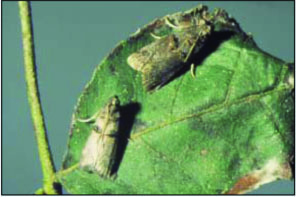
By Jeanette Castanon
One of the most important nut-infesting insect pests of pecan is the pecan nut casebearer. It is found in all pecan-growing regions of Texas and in south eastern New Mexico. Casebearer larvae tunnel into nutlets shortly after pollination, often destroying all nutlets in a cluster.
The adult casebearer is a gray to almost black moth about 1/3 inch long. A ridge of dark scales followed by a band of lighter color runs across the fore-wings. Moths are active only at night, when they mate and lay eggs on pecan nuts. Each female lays 50 to 150 eggs during her 5- to 8-day life.
Eggs are oval, flat and tiny, just large enough to be seen with the unaided eye. When first laid, eggs are greenish-white or white. Tiny red spots soon appear on the egg, giving it a pink color before hatch. Casebearer larvae are olive-gray to jade green and grow to about 1/2 inch long.

First-generation casebearer eggs are typically deposited on pecan nutlets soon after pollination. Eggs hatch in 4 to 5 days. Young larvae crawl to nearby buds to begin feeding, leaving empty white egg shells on the nut. The tiny larva feeds for a day or two on a secondary bud at the base of a compound leaf before it enters the pecan nut. Larvae generally tunnel in at the base of the nutlet. Silk and black frass (excrement) are often visible outside infested nuts.
Casebearer larvae feed for about 4 to 5 weeks, depending on the temperature. Full grown larvae then enter the pupal stage inside the nut. The moth emerges 9 to 14 days later.
Insecticide applications must be timed accurately to control newly hatched casebearer larvae before they enter the nuts. Once inside, larvae are protected from insecticide treatments.
In spring, examine nutlets carefully for casebearer eggs to determine:
Whether egg infestations are high enough to justify treatment and when to apply insecticide.
Often, most eggs are laid during a two-week period in late April to early May in the southern and coastal areas of Texas, and late May and early June in north Texas.
Be careful when applying insecticide sprays in backyard and urban areas, because spray may drift onto nearby gardens, pets and living areas. In home landscapes, use only products containing Spinosad (Green Light Lawn and Garden Spray with Spinosad®), carbaryl, malathion or Bacillus thuringiensis and that are labeled for pecans.
Before purchasing and applying any insecticide, always read the label to determine if the product is labeled for use on the target plant or site. Follow mixing instructions and safety precautions.



